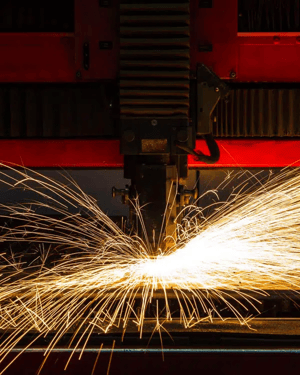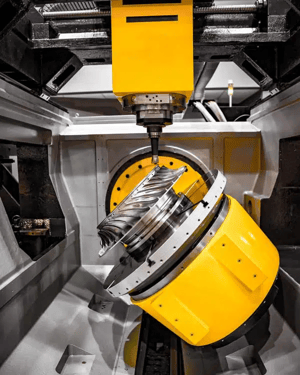CNC, or Computer Numerical Control, is a computerized system of code that performs various manufacturing operations, usually for the metalworking industry. This type of code is usually written with software programs to help map out things like tool paths.
NC to CNC
In the ‘70s and ‘80s, before CNC machining, there was NC machining. This non-digital form of machining was essentially a long, thin strip of paper that fed into the “brains” of the machine to be read as individual lines of G-code, which told the machine to move/cut various operations. G-code is essentially a list of positions and commands that tells the machine to “move to ___ point, cut from __ to __, running at __ spindle speed.” As the technology progressed, computers became more readily available, and CAM (Computer-Aided Manufacturing) software came onto the scene, changing things quite drastically. There was no longer a need for hard copy paper running into a machine. Programmers could now write lines of code in a computer, which was directly fed into the “brains” of these newer CNC machines.
CAD to Finished Part
Going from an idea/concept to a finished product involves a few steps the designer/machinist must go through. Often, there are several people involved with these steps, such as CAD Designers, Manufacturing Engineers, Machinists, and sometimes, even more, depending on the complexity of the machining needed. Here’s a brief overview of a typical machining process:
CAD Design
Before any product is made today, it starts with a designer creating the geometry/prototype in a CAD (Computer-Aided Design) system where edits can be made on the fly.
CAM Programming
Once the ideal design is nailed down, a CAM programmer (G-code) will assist with writing code to tell the CNC machines where and when to move. Programs such as Powermill or MasterCAM are popular among the machinist community for creating toolpaths/simulating the manufacturing process.
Machine Setup/Fixturing
Now that the precise materials, tool paths, and processes needed to get to a finished part are known, fixturing and tooling is the next step. Various molds & tooling will be made ahead of time to hold/nest the workpiece being machined.
Types of CNC Machine Tools

CNC Laser cutters/Water Jets
These are both forms of subtractive manufacturing where a cutting object is removing material from a workpiece to shape the finished piece. Both laser engraving and water jetting are forms of 2D CNC manufacturing.

cnc Turning Machines/Lathes
In these types of machines, the workpiece is held in a chuck that is continuously spinning while the cutting tool remains stationary. Only round parts are cut on lathes, where the static tool is pressed against the workpiece to form/shape it into the finished part. Lathes will often have various tools to perform threading, radiusing, and other types of finishing on the round (typically metal) parts being held in the chuck.

cnc Drilling/Milling Machines
Similar to manual drill presses, this CNC machine is an automated 2- or 3-axis machine that is used to perform simple milling/drilling applications. In this machine, the workpiece is clamped to a table, remaining stationary as the cutting tool moves around it to perform various operations on the raw material.

cnc Machining Centers
Often enclosed and with 3 or more axes, machining centers are geared towards the high production, high mix machining market. These often have an assortment of tools that are automatically changed throughout various machining operations and several other accessories to accommodate the workload these machines tend to receive.
what industries use cnc machining and what applications does it suit best?
automotive & transportation
Along with robotic welding, automated press/stamping/fabrication, and high-tech automation technology.
defense
All branches of the military utilize CNC machining at a large capacity for maintenance of vehicles, weaponry manufacturing, and a variety of other metalworking applications.
aerospace
Anything that is flying in the sky, the atmosphere, or in orbit was likely manufactured by way of CNC in some manner. Large aerospace components are critical for payloads, rockets, & the satellite business as of recently.
medical devices
The large-scale rollout of COVID-19 vaccinations, for example, could not have been achieved without the assistance of CNC machining and a variety of other automated processing practices.
general industry
CNC milling & turning are essential for a variety of manufacturing companies in many ways, including low volume/prototype production, high production runs, and everything in-between.
cnc machining Career Opportunities
There are a variety of careers related to CNC machining. Varying levels of education are required, but all of them can be very sustainable, long-term careers with good pay.
CAD Designer
Before any new idea/product is developed in the real world, there must be a designer/draftsman who envisions and constructs that prototype in a CAD software package to define its shape, features, etc.
CAM/CNC Programmer
In order to plan for the machinery to perform various cuts, milling, and/or other metal cutting applications, a CAM/G-Code programming engineer is crucial, especially to ensure Design for Manufacturability (DFM).
Manufacturing Engineer
A Manufacturing Engineer ensures that the machinery/equipment is capable of handling the particular type of metal, process, or finish required.
cnc Machine Operator/Machinist
A CNC Machinist / Machine Operator helps to make sure that a part goes through its necessary stages of processing to create a finished piece, whether that be milling, turning, grinding, or any other manufacturing process.
Quality Assurance/Inspection
Typically with the help of metrology equipment and other measurement devices, Quality Assurance Engineers/Technicians work to ensure tight tolerances and proper finishes for machined parts.
The Industry's Leading CNC Machining Source
Baker Industries, a Lincoln Electric Company, provides industry-leading, large-scale component machining, especially for automotive & aerospace applications. Whether you need a provider of 3D printing (Additive Manufacturing), CNC machining, or other fabrication processes, Baker will help bring your concept to reality. We are a trusted partner of SpaceX, NASA, Rivian, and other innovative automotive and aerospace startups, OEMs, and Tier 1 companies. Specializing in large-scale and low-volume production work, we have the right equipment and staff for just about any industrial manufacturing job. For a quote, please reach out to us.


